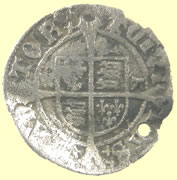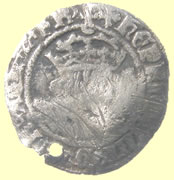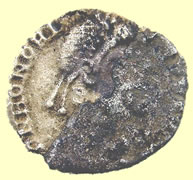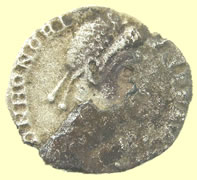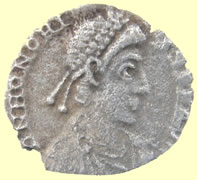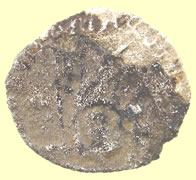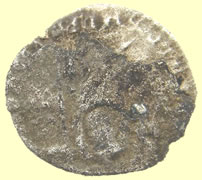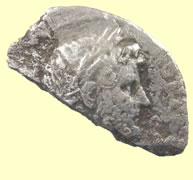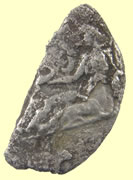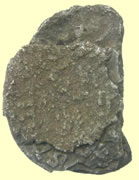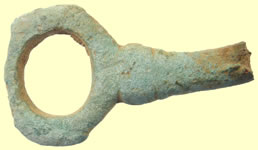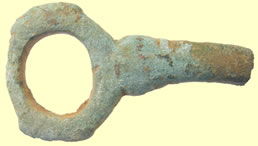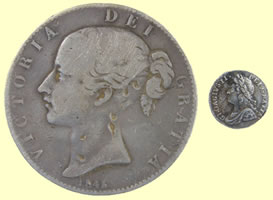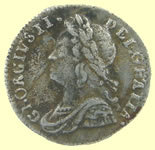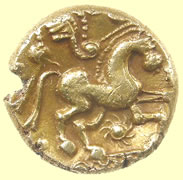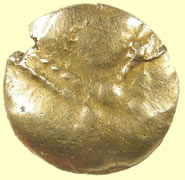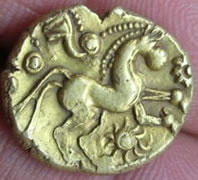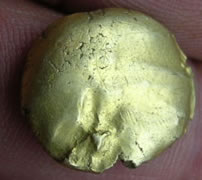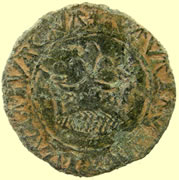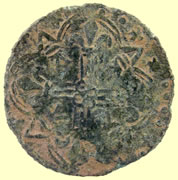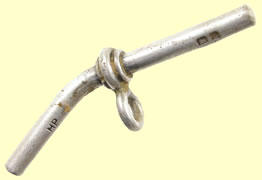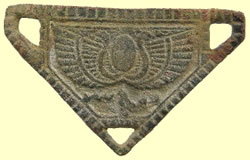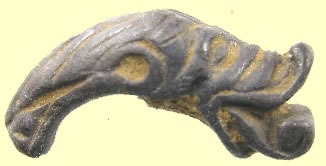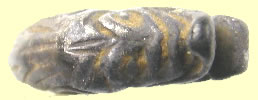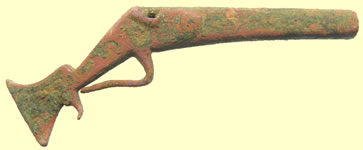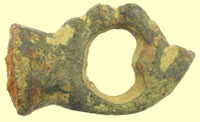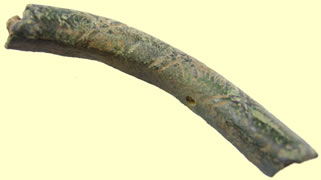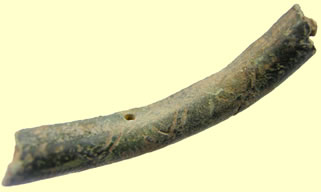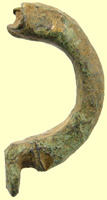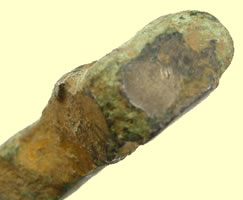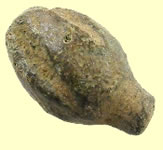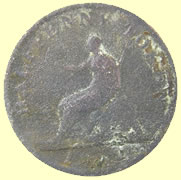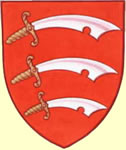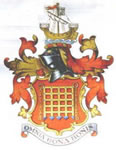

Metal detecting holidays in England with the World's most successful metal detecting club.
Twinned with Midwest Historical Research Society USA
November 2008 Finds page 2 |
*** Latest finds posted the new hunt page 2009 Feb finds |
|||||||||
  |
|
||||||||
Most perfectly stuck legend I have ever seen 1279 Edward III hammered silver penny - class 10ab obv EDWAR R ANGL DNS HYB obv CIVI/TAS/CAN/TOR |
1526-32 Henry VIII hammered silver halfgroat- cross patonce Archbishop Warham - WA by shield -Canterbury mint |
||||||||
This coin has been 'cooking' for several weeks now and is very slowly revealing the detail. 5thC Roman silver siliqua of Honorius
|
|||||||||
Roman 2nd C silver coin ? 1.14g, 17.45mm This Roman silver coin fragment was just a thick crispy disc when Mass Mike dug it. I put it in the 'cooker' last Saturday and an amazing result to reveal a very pretty coin. I have sent it off to Mark Lehman for ID |
|||||||||
BC Roman Republican silver coin ? 1.25g, 16.42mm Another Roman silver dug by NS Andy with very thick 'horn crust' that is 'cooking' to reveal the detail. This Roman is also laminating badly but there is some legend on the reverse. I will have to cook this some more before I seen it off for ID. |
|||||||||
 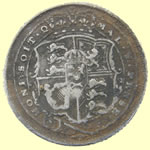 |
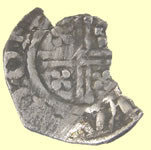 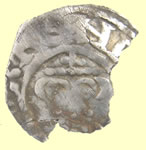 |
||||||||
1820 George III milled silver sixpence |
1247 Henry III hammered silver short cross penny |
||||||||
 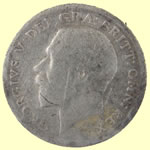 |
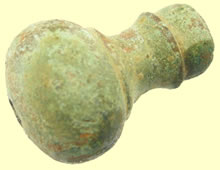  |
||||||||
1911 George V milled silver sixpence (123) |
17thC knife pommel |
||||||||
|
|||||||||
Roman swivel cart fitting ? one for the museum
|
|||||||||
 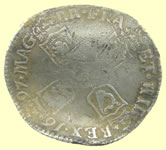 |
  |
||||||||
1697 William III milled silver sixpence (124) |
16thC Elizabeth 1st hammered silver half groat |
||||||||
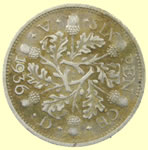 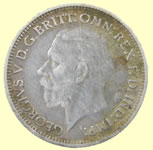 |
 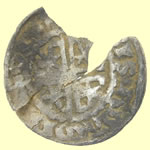 |
||||||||
1936 George V milled silver sixpence (124) |
This appears to be an extremely rare 1205 - 1230 AD William 1st The Lion of Scotland short cross hammered silver penny. The obv legend clearly shows a 'US' which only matches one moneyer Henri Le Rus whuch is classed as extremely rare, great find obv LEI REI WILAM rev HENRI LE RVS .ON.RORE |
||||||||
 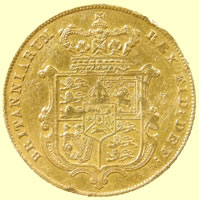 |
|||||||||
1827 George IV gold guinea
|
|||||||||
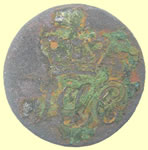 |
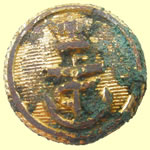 |
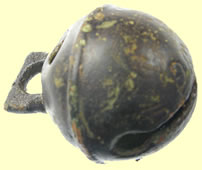 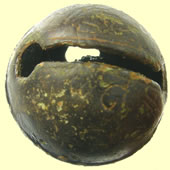 |
|||||||
Military button - not checked ref books yet |
Royal
Navy - Officers (Roped Rim) Unlined Background 23mm - 1891-1901 |
18thC 1770-1820 AD crotal bell with makers mark WG - Willian Gwynn Aldbourne |
|||||||
  |
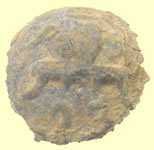 |
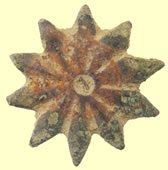 |
|||||||
1592 Elizabeth 1st hammered silver 6 pence |
18thC 23rd regiment of foot button |
Medieval spur rowel |
|||||||
 |
|
||||||||
Incomplete
harness strap distributor (probably a bridle cheek piece) of the late
Anglo-Saxon to early Norman period circa 10thC |
|||||||||
 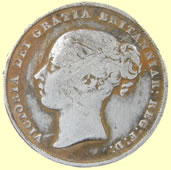 |
|
||||||||
1844 Victorian milled silver shilling (125) |
circa 10thC Saxon bronze key - decorated |
||||||||
Little and large - Victorian 1845 Crown (60 pence) and the George penny
Tiny 1732 George II milled silvcer one penny (126) |
|||||||||
 |
 |
 |
|||||||
18thC clog fastener |
1550-1650 spur buckle |
A small meeting was opened at the Carlton Club in London on the 17th November 1883 and the 'Primrose Tory League' (the Tory part of the title was soon to be dropped) was launched by Lord Randolph Churchill, (father of Sir Winston Churchill), Mr. (later Sir) John Gorst, Sir H. Drummond Wolff, Mr. Percy Mitford, Colonel Fred Burnaby, Sir Alfred Slade and others, who constituted themselves the Grand Council of the Primrose League. |
|||||||
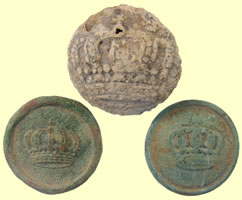 |
 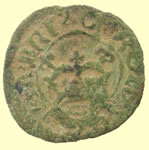 |
||||||||
Prussian Army buttons - from brass 1880's type to 1914-18 type when they ran short of good metal in Germany during the WWI |
1634 Charles 1st hammered copper rose farthing - type 2 |
||||||||
 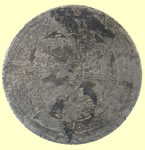 |
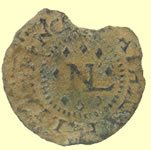  |
||||||||
1820 George III milled silver sixpence (127) |
1662 Nathaniel Lawerence Colchester hammered copper trade farthing |
||||||||
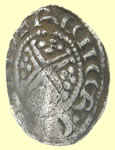 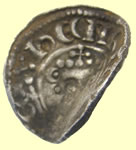 |
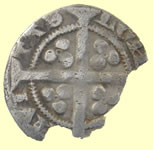 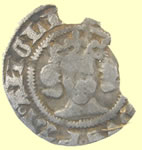 |
||||||||
1199 AD King John hammered silver penny - Class 5b2 Obv HENRICVS REX Obv RENER.ON. LVND Moneyer Rener - London mint 1.34g, 17.88mm |
Very unusual hammered silver penny obv legend show ***DVS REX ANGI with annulets stop between words. This should be an Edward III pre treaty or post treaty coin but there are no coins with annulet stops on reverse. obv ***DVS REX ANGI Obv CIVI/TAS/LON/DON 0.80g, 17.36mm |
||||||||
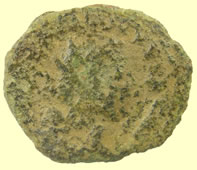 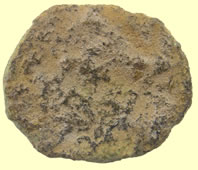 |
|||||||||
4thC Roman bronze 3.75g, 22.09mm sent for ID All I'm gong to be able to do with this one is give your some general info on the period - I won't be able to assign this one to a specific ruler, but I can place it in a fairly tight time-frame. This is either a very late antoninianus or its successor under Diocletion's reforms, the purely AE "Post-reform Radiate" which was a fraction of the new "flagship denomination" the Follis. Since the basically AE radiate Antoninianus had been virtually the only coin in circulation for the 25 or 30 years prior to Diocletian's reforms, it is assumed that the general familiarity with this coin-type was the reason that a coin of this type was carried-over into the new system, looking almost exactly like the old ones This is probably either Diocletian or Maximian - the first two emperors in the administrative partnership which soon became the Tetrarchy. The reverse appears probably to be CONCORDIA MILITVM - which was a very common reverse for both the late Antoniniani and the Post-reform Radiates. Both denominations, nearly indistinguishable from each other, are typified by the radiate crown (crown of Sol or Helios) worn by the emperor on the obverse. The reverse of this one has (I believe) two figures clasping hands or one giving the other a small Victory-figure on a globe. This will usually be the emperor on the left receiving the Victory from Jupiter on the right - or occasionally a more allegorical scene of the emperor clasping hands with a figure representing, in some way, the armies. Diocletian became emperor in 284 AD, at the end of the political and monetary chaos of the 3rd century. He soon - in 286 - added Maximian as his co-emperor. The bulk of his monetary reforms were accomplished in the early 290's AD, so this coin is from the approximate period, 285-300 AD. Mark |
|||||||||
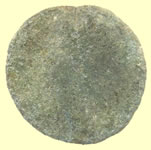 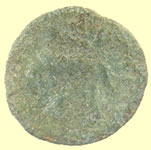 |
|||||||||
Roman bronze coin with animal on reverse - sent for ID almost over-thought this one (hearing hoofbeats, I began to go off looking for zebras, I guess) before I realized what a common type it really is. This is an VRBS ROMA City Commemorative issue for Rome, c. 330-337 AD.
When Constantine moved his capitol to Constantinople c. 330 AD., alongside the normal Imperial portrait types, he decreed a massive issue of coins commemorating both Constantinople and Rome: The "CONSTANTINOPOLIS" types which also use an allegorical personification of "the city" as an armed and helmeted female bust facing left and have a reverse type of Victory on the prow of a galley - and this VRBS ROMA type with the "animal" reverse. The reverse type for Rome is the foundation-myth scene of the shewolf suckling the twins, Romulus & Remus with two stars in the field above. This reverse type is actually a part of the logo of Ancient Coins for Education, Inc, the non-profit educational enrichment organization for which I work. http://www.ancientcoinsforeducation.org
Here's a representative specimen of the VRBS ROMA type from my collection:
and a CONSTANTINOPOLIS type for comparison:
These two were companion types and issued simultantously between 330 and about 337. These same two obverses are also known with the GLORIA EXERCITVS, 2 soldiers flanking a military standard reverse between 337 & 340 or so - these were struck, interestingly enough, when the succession of the Principiate was contested just after Constantine's death - it was a way a neutral mint-city could dodge the issue of seemingly supporting one of Constantine's warring sons over another in the conflict.
Mark
|
|||||||||
 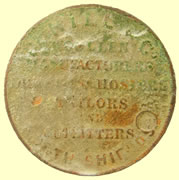 |
  |
||||||||
West of England House, The cheapest goods in all England Est 1825 Newcastle, Sunderland |
Tricky coin - Medieval hammered silver penny - 2 rings in reverse cross is Henry VI Durham only but the part legend is *** ARD which is Richard or Edward - needs more reserch |
||||||||
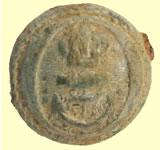 |
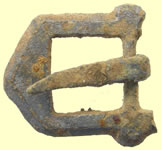 |
 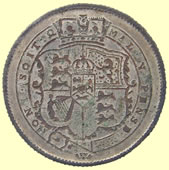 |
|||||||
RN Petty Officer - 1891 |
1550 -1650 spur buckle |
1820 George III milled silver shilling forgery |
|||||||
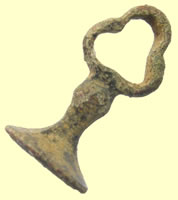  |
 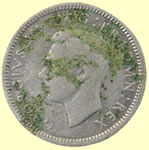 |
||||||||
Late 16thC seal matrix with Fleur de Lis impression |
1939 George VI milled silver sixpence (128) |
||||||||
  |
 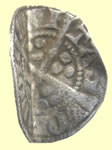 |
||||||||
1180 -1199 Henry II hammered silver half penny - Class 3 0.44g, 16.25mm obv HENRIVS REX rev ***ENVS |
1279 Edward 1st hammered silver penny - Cross potent Class 1d obv EDWR ANGL DNS HYB Rev CIVI/TAS/LON/DON - London mint 1.23g, 18.82mm |
||||||||
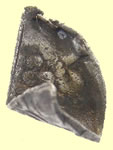  |
  |
||||||||
1247 Henry III hamered silver voided long cross half penny 0.62g |
1341 Edward III hammered silver penny - Florin issue obv EDWAR REX ANGL DNS HYB Rev CIVI/TAS/CAN/TOR - Canterbury mint 1.21g, 18.52mm |
||||||||
 |
 |
 |
|||||||
17thC Charles II hearts and arrows silver button - reported as treaure to Colchester museum |
18thC Royal artillery button |
Saxon pin head - ridge on shaft |
|||||||
 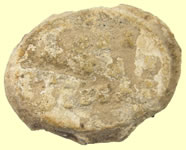 |
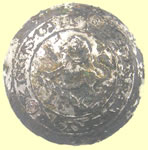 |
 |
|||||||
1788 German lead bale seal |
2nd Unrecorded 4th Reg button we have found
|
1814 Russian copper coin |
|||||||
 |
 |
||||||||
Roman hanging pendant - decorated on all four side with classic circle motif |
Small medieval chisel or scraper |
||||||||
 |
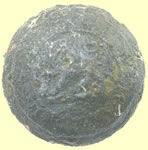 |
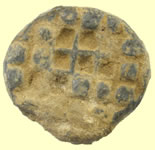 |
|||||||
Lots of 18thC Royal artillery buttons being found |
3rd Unrecorded 4th Reg button we have found
|
Early lead gaming pice - needs more research |
|||||||
  |
 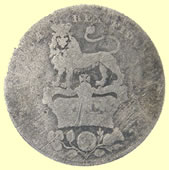 |
||||||||
17thC flower decorated belt slide |
1826 George IV milled silver shilling (129) |
||||||||
  |
 |
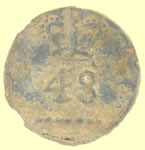 |
|||||||
1923 George V milled silver sixpence (130) |
Georgian combined watch winder seal matrix |
18thC Unrecorded 48th regiment of foot button |
|||||||
 |
 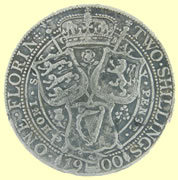 |
||||||||
Neat eyeball fossile find |
1900 Victorian milled silver Florin (24 pence) (131) |
||||||||
  |
|||||||||
4thC Roman bronze sent for ID You're generally correct, but in addition to Constantine I himself, these were struck for the whole Constantinian gang, including a couple nephews who are hardly more than footnotes in the Imperial line. We won't be able to tell for whom this one was struck since none of its obverse legend survived, but since it's a single-standard GLORIA EXERCITVS it can be dated to the period of 335-345 AD. The single-standard types were struck for Constantine, and for his sons when they were Caesars as well as for his sons after his death when all three became Augusti in their own right.
After the FEL TEMP REPARATIO - Soldier spearing fallen horseman type which followed this type, the GLORIA EXERCITVS - soldiers and standard(s) is probably the 2nd most common coin-type of antiquity.
Mark
|
|||||||||
 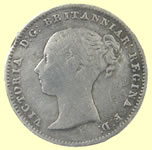 |
  |
||||||||
1854 Victorian milled silver 3 pence (132) |
1842 Victorian milled silver shilling (12 pence) (133) |
||||||||
 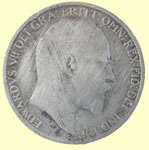 |
  |
||||||||
1910 Edward VII milled silver 6 pence (134) |
1933 George V milled silver sixpence (135) |
||||||||
  |
 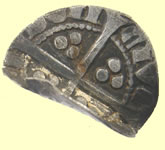 |
||||||||
1696 William III milled silver 6 pence (136) |
1341 Edward III hammered silver penny - Florin issue obv EDWAR ANGL DNS HYB Rev CIVI/TAS/LON/DON - London mint
1.09g, 16.41mm |
||||||||
 |
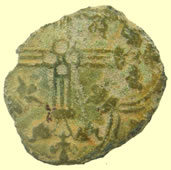 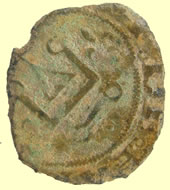 |
||||||||
Victorian silver item |
15thC French stock Jetton of Sedan - The use of 'cross feuilly' suggests a Northern mint. Ref Mitchener 712 |
||||||||
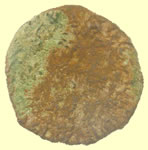 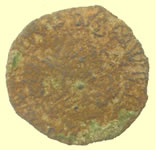 |
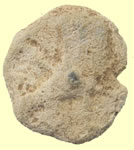  |
||||||||
17thc hammered copper trade farthing |
Early medieval lead token |
||||||||
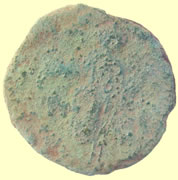 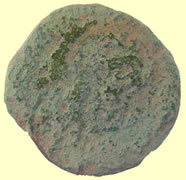 |
 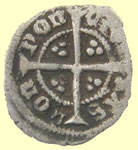 |
||||||||
Huge 1stC Roman bronze coin - sent for ID 10.56g, 30.85mm |
1377-99 AD Richard II hammered silver farthing (1/4 penny) Type 1 neck missing: from the same punches as those used for Edward III types 9 and 10 obv +RICARDVS:REX:ANGL rev CIVI/TAS/LON/DON -LONDON MINT 0.34g, 10.06mm |
||||||||
 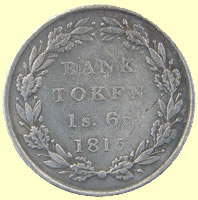 |
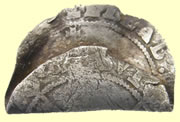  |
||||||||
Stunning 1815 Bank of England issue George III milled silver 1 shilling and 6 pence (18 pence) (137) |
1598 Elizabeth 1st hammered silver 6 pence - 6th issue key mintmark |
||||||||
  |
 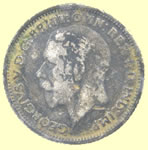 |
||||||||
1247 Henry III hammered silver voided long cross half penny Type IIIa obv HENRIVS REX rev hE(N/RIO/NLV/NDE - Henry - London |
1929 George V milled silver sixpence (138) |
||||||||
  |
  |
||||||||
1834 William IIII milled silver 4 pence (139) |
1752 George II copper half penny coin |
||||||||
Latest Celtic gold 16.76mm,5.89g
NS Andy's Celtic gold from last season 5.73g, 17.13mm CCI 07.1164 |
|||||||||
Very interesting and rare Celtic gold find, same tribe as that found by NS Andy latest season but from a different die type This was the feedback from Dr Philip at the Celtic coin index on NS Adny's gold when I recorded it 'This is quite a rare type, as you no doubt appreciate. The best parallel is provided by three coins in the British Museum, listed in their catalogue as nos. 3353-55. It's one of a group of coins loosely described as the Snettisham staters, because several of the types were first recognized in one of the Snettisham (Norfolk) hoards of the early 1990s. The exact type is not in Van Arsdell although it's closely related to the North Thames types listed as VA 1500, 1502 and thereabouts. It is presumably an East Anglian type, although because of the stylistic similarities there must have been some very strong link between the producers of the Snettisham types and the North Thames types. Date c. 50 - 40 BC, I think.
I have sent the lastest one off to Dr Philip at the CCI for recording and further comments.
|
|||||||||
 |
 |
 |
|||||||
Royal Horse Artillery
Generic Issue Officer & O/R's - 1873-1901 |
17thC hand decorated button |
1670's Charles II silver cufflinks reported as treasure to Colchester museum |
|||||||
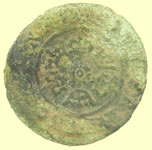 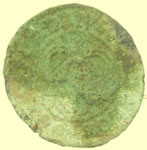 |
 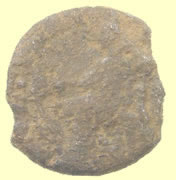 |
||||||||
1586 Hans Krauwincel II Rose orb Jeton HANNS KRAVWINCKEL IN NVRENB |
Roman republican looking silver coin - 'cooking' to reveal detail. sent for initial ID 14.88mm, 1.61g |
||||||||
 |
 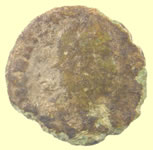 |
||||||||
Post medieval lead bale seal
|
4thC Roman bronze sent for ID16.26mm, 1.97g This is Valentinian I, 364-375 AD, the co-founder of the Valentinian Dynasty along with his brother Valens, the same Valens who was killed in what was possibly the worst defeat ever suffered by Rome in a single battle - the massacre at Hadrianopolis in 378 - in which "the Goths rode-down the flower of the Roman legions" and virtually annihilated the Roman army in a single battle. Things were mostly downhill for the Western Empire from this point onward, and only 32 years later, the Goths would sack Rome during the lackluster rule of Honorius. About the best that could be said about Valentinian I is that he was lucky enough not to live to see his brother's great defeat.
The reverse type is GLORIA ROMANORVM and shows "the Emperor" walking right dragging a "barbarian captive" and carrying a labarum - a standard with the Chi-Rho symbol on it.
This type, and the companion SECVRITAS REIPVBLICAE, walking Victory AE3's, were struck in vast numbers at all the Roman mints throughout the joint reigns of Valentinian I, Valens and Gratian, Valentinian's son, from 364 until about 383 AD.
Mark
|
||||||||
  |
  |
||||||||
Medieval pocket Lead sundial with segmented decoration and roman numerals 1200 AD |
1634 Charles 1st hammered copper rose farthing |
||||||||
 |
 |
  |
|||||||
Georgian button |
1550-1650 buckle |
1625 Charles 1st hammered silver penny |
|||||||
 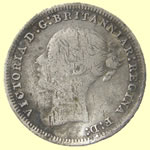 |
 |
 |
|||||||
1879 Victorian milled silver 3 pence (140)
|
15thC spur rowel |
1855 6th Inniskilling Dragoon Guards button |
|||||||
 |
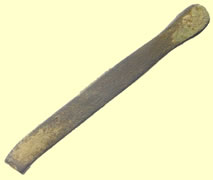 |
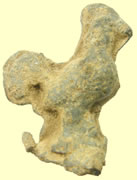 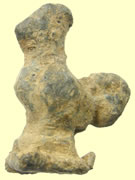 |
|||||||
RN Capt
/ Commander - 1787 RN Lieutenant - 1787 |
Medieval ear wax scraper |
Medieval Lead cockeral - pilgrims badge |
|||||||
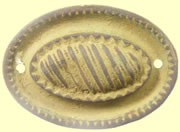 |
 |
  |
|||||||
Georgian harness mount |
Georgian button |
1696 William II milled silver 6 pence (141) |
|||||||
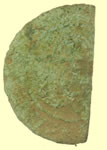  |
  |
||||||||
1586 Hans Krauwincel II Rose orb Jeton HANNS KRAVWINCKEL IN NVRENB |
17thC mount with 2 integral lugs |
||||||||
 |
 |
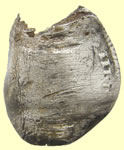 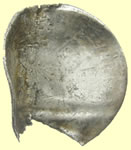 |
|||||||
19thC hunting button |
Generic Merchant Navy Officers |
1696 William II milled silver 6 pence (142) |
|||||||
 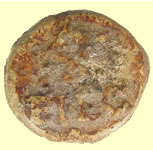 |
  |
||||||||
Post medieval lead bale seal |
1558 Elizabeth 1st hammered silver penny - 1st issue Lis mintmark |
||||||||
 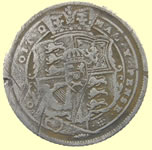 |
|
||||||||
1816 George II milled silver 6 pence (143) |
Mint condition 1340 AD French Jetton Crown introduced in 1340 by Philip VI (1328-50) Royal Crown with 3 rosettes across body of crown Rev Triple banded straight cross fleuretty AV |
||||||||
 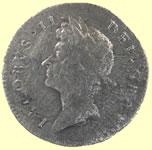 |
 |
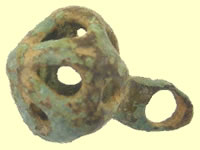 |
|||||||
1687 James II milled silver 3 pence (144) |
Generic Merchant Navy Officers |
16th Tudor fretwork buckle |
|||||||
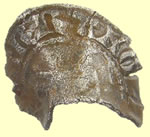 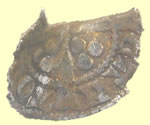 |
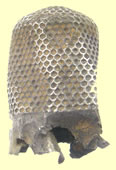 |
 |
|||||||
1341 Edward III hammered silver half penny - Florin type Obv EDWAR R ANGL ***** Rev CIVI/TAS/CAN/TOR - Canterbury mint |
Georgian silver thimble |
Musket ball with spruce attached |
|||||||
 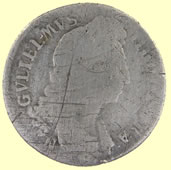 |
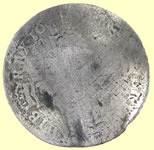 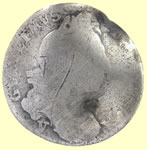 |
||||||||
1696 William II milled silver shilling - Norwich mint (145) |
1696 William II milled silver sixpence - York mint (146) |
||||||||
  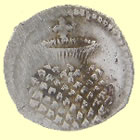 |
|||||||||
Tiny 1619-25 James 1st hammered silver half penny - no legend type in mint shape |
|||||||||
 |
 |
 |
 |
||||||
18thC lead sewing palm guard |
1500-1650 Cast copper alloy buckle |
Post medieval lead cloth seal |
Roman prick spur fragment |
||||||
  |
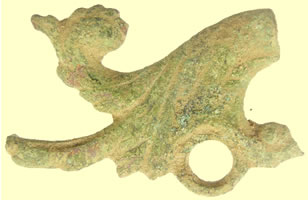 |
||||||||
Medieval Lead stamp - cross design |
Musket decoration ? |
||||||||
 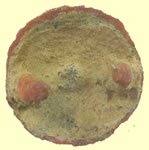 |
 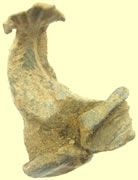 |
||||||||
17thC circular mount with 2 integral lugs |
Medieval lead pilgrims badge |
||||||||
 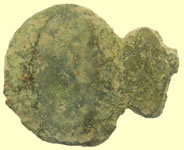 |
 |
 |
|||||||
C10C Saxon key handle |
Lead Georgian carriage mount |
Roman harness ring |
|||||||
 |
 |
 |
|||||||
Georgian button |
Medieval lead shield weight |
17thC cast copper alloy figure mount |
|||||||
 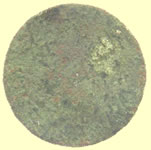 |
 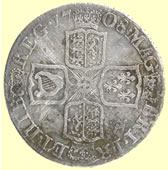 |
||||||||
1664 Joseph Gleeson of Dedham hammered copper rose farthing |
1708 Queen Anne milled silver shilling (12 pence) (147) |
||||||||
 |
 |
 |
|||||||
Georgian button |
Poor mans Saxon strap end made of lead ? |
Idaho Gerry's silver hoard - Dutch cache LOL |
|||||||
  |
 |
 |
|||||||
1915 George V milled silver sixpence (148) |
WWI Royal airforce button |
Georgian watch winder shaped like an arrow |
|||||||
  |
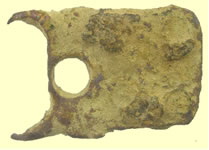 |
||||||||
17thC mount with 2 integral lugs |
Medieval buckle with integral chape |
||||||||
  |
 |
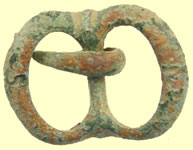 |
|||||||
1842 Victorian milled silver shilling (149) |
RN Capt / Commander - 1787 RN Lieutenant - 1787 |
1550 -1650 buckle |
|||||||
  |
 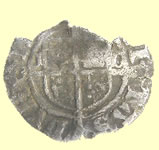 |
||||||||
1180 -1199 Henry II hammered silver half penny |
1490-1504 Henry VII hammered silver sovereign penny, Pansy mintmark Bishop Richard Fox issue - letters by shield (1494-1501) Obv King entroned holding septre and orb Rev CIVI/TAS/DVR/REM - Durham mint 14.69mm, 0.50g |
||||||||
 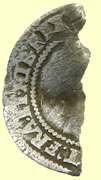 |
 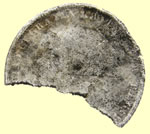 |
||||||||
1613-15 James 1st hammered silver 6 pence |
1858 Victorian milled silver 6 pence (150) |
||||||||
 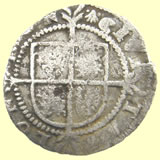 |
 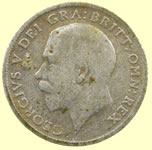 |
||||||||
1584-6 Elizabeth 1st hammered silver half groat (2 pence) Escallop mint mark - 6th issue |
1921 George V milled silver sixpence (151) |
||||||||
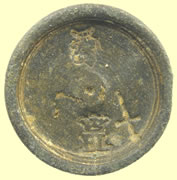 |
|
||||||||
Stunning 16thC Tudor Elizabeth 1st trade weight - Crown EL London hall mark. |
Silver fob watch bar - 1915 hall mark |
||||||||
 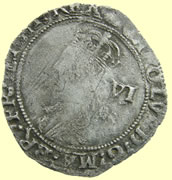 |
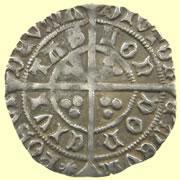 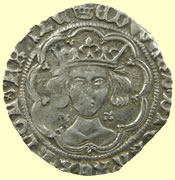 |
||||||||
1633-4 Charles 1st hammered silver sixpence- Tower mint under Charles - Portcullis mint mark, Group D CR at sides of shield |
1467 -68 AD Edward IV hammered silver groat (4 pence) Crown intial mark/sun obv -Quatrefoils by neck Type VIII obv EDWARD DI GRA REX ANGL Z FRANC CIVI/TAS/LON/DON - London mint |
||||||||
  |
|
||||||||
Medieval decorated rectangular washer |
Interesting piece - what looked like a Victorian mount appears to be an egyptian design and could be Roman - one for the museum to look at |
||||||||
  |
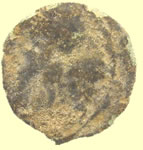 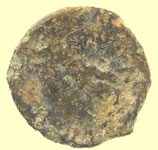 |
||||||||
1603 James 1st hammered silver 6 pence |
4thc Roman bronze coin |
||||||||
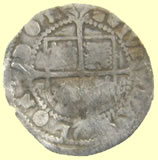  |
 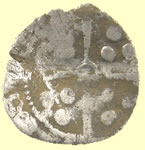 |
||||||||
1592-5 Elizabeth 1st hammered silver half groat (2 pence) Tun mint mark - 6th issue |
1461 -70 Edward IV hammered silver penny -Durham mint - Bishop Lawrence Booth issue B&D by bust - B in centre of reverse |
||||||||
 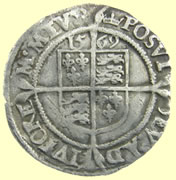 |
  |
||||||||
1569 Elizabeth 1st hammered silver 6 pence -Coronet mint mark - 4th issue
|
1490-1504 Henry VII hammered silver sovereign penny, No initial mark Archbishop Rotherham issue - key beneath shield Obv King entroned holding septre and orb,two double pillars Rev York mint
|
||||||||
  |
 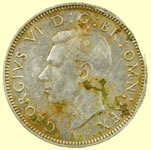 |
||||||||
Lord Wellington campaign medallion 1809 -15 Talavera Vittoria Badajoz Waterloo |
1942 George V milled silver sixpence (152) |
||||||||
 |
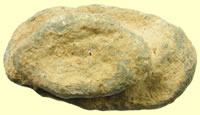 |
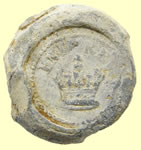  |
|||||||
16thC Tudor clothing fastener |
Lead pot mend |
Inland revenue lead bale seal |
|||||||
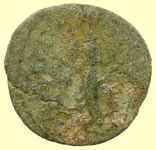 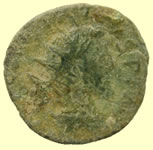 |
|||||||||
3rdC Roman bronze coin sent for ID 16.91mm, 2.25g This one appears to be an AE Antoninianus of Tetricus I - or a contemporary copy of one. As encrusted as this is, and with so little of the legends readable, I probably can't say a lot more about it. I can't be sure about the reverse type, but PAX AVG is a really common reverse type for both the official issues (of the Gallic Empire) and the local copies. This one looks as though it could be Pax as easily as any of the other, common standing personification reverse types.
Tetricus' dates were 270-273 AD - when, after surrendering to Aurelian, ceding "his" Gallic Empire back to Rome, and encouraging his troops to join with Aurelian's legions, he and his son, instead of suffering the normal fate of "rebels" (the actual rebellion had taken place 20 years earlier under a whole different generation of rulers), were brought back to Rome to march in Aurelian's triumph and were taken care of in great style, being made honorable members of the Senatorial class for the remainder of their lives.
If it is a "contemporary copy", and contemporary copies are very commonly found in the UK and northern France, it could be up to 2 or 3 years later, but the old theory that these so-called "barbarous radiates" (a term I neither like nor use) date to the time after the Romans abandoned Britannia has been thoroughly disproved by recent archaoelogical evidence of hoards and even "forgers' tools" dating specifically to the era of 270-275 or so. It can be relatively difficult to tell the difference in some cases between official pieces and local copies - some, however, belong to the "minim" class and can be found as small as 8 or 9 mm - others distinguish themselves by their extreme crudeness.
Mark
To give you an idea of the breadth of difference possible between official and unofficial
here's a specimen that's almost certainly official:
Another official piece and another potential reverse type yours might be:
Here's one that's might be official or might be a copy:
and here's one about which there can be almost no doubt that it's a contemporary copy:
And here's an example of just how bad the copies can be:
|
|||||||||
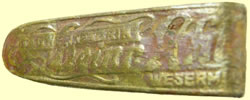 |
 |
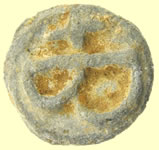 |
|||||||
20thc pen knife handle |
16thC Tudor fretwork button |
17thC lead trade token |
|||||||
|
|||||||||
Superb Roman silver dolphin buckle fragment reported to the museum as treasure 15.52mm L x 4.76mm T ,2.03g |
|||||||||
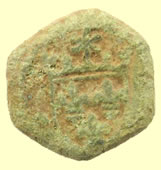 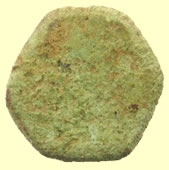 |
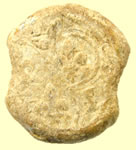 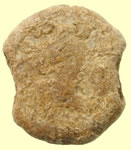 |
||||||||
1475 French uniface gold 'ecu au soleil' coin weight - Hexagonal French issue with sun above 3 lis in a shield |
French Post medieval lead bale seal |
||||||||
 |
 |
  |
|||||||
19thC Livery button |
18thC Army button - Fuseliers |
1199 AD King John hammered silver cut half penny Class 6a2 .***M.T.ON.LVD - Moneyer Willelm T of London |
|||||||
 |
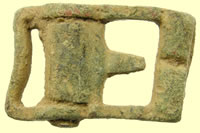 |
 |
|||||||
Scottish regiment cap badge |
Georgian spur buckle |
1824 97th Regiment of foot |
|||||||
 |
 |
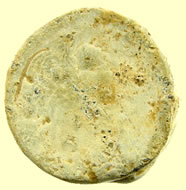 |
|||||||
17thC nipple button |
1550-1650 buckle |
17thC Plummer mark 1/4 pound trade weight - angel stamp
|
|||||||
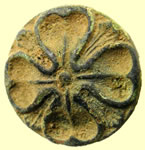 |
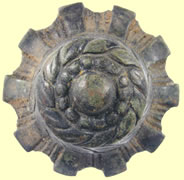 |
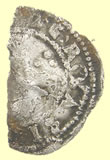 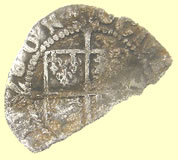 |
|||||||
Georgian button
|
Victorian harness decoration |
1600 Elizabeth 1st hammered silver half groat 6th issue - O mintmark |
|||||||
17thC working toy petronel (pistol) - possible blow out to the barrel due to overpacking of gun powde |
|||||||||
Very interesting Anglo Saxon looking hammer with classic circle decoration - 46.54mm H x 47.43mm W , 23.29g This could even date right up to the late Medieval period with this design It could well be a working hammer as the fused wire handle is hollow to possibly take a shaft or it is a votive offering of some sort - one for the museum to play with |
|||||||||
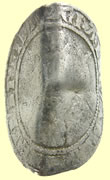 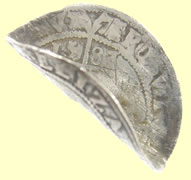 |
  |
||||||||
1583 Elizabeth 1st hammered silver sixpence - A mint mark - 6th issue |
1586 Hans Krauwincel II Rose orb Jeton HANNS KRAVWINCKEL IN NVRENB |
||||||||
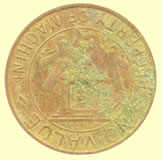 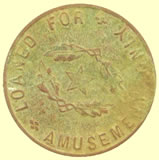 |
 |
 |
|||||||
20thC slot machine token |
Medical corp button ? |
19thC livery button |
|||||||
 |
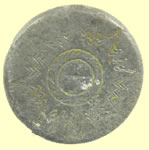 |
|
|||||||
Georgian brooch |
18thC button |
Not sure on this one yet - could be a Roman reigns guide |
|||||||
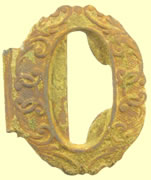 |
|
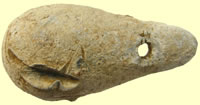 |
 |
||||||
19thC belt buckle |
Roman buckle tongue |
Post medieval lead hanging weight | 18thC Royal artillery button |
||||||
|
|||||||||
Interesting Roman piece - socketed end to support a shaft - medical implement ? - one for the museum |
|||||||||
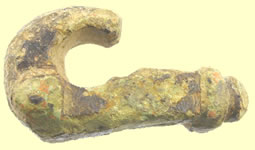 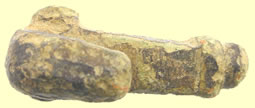 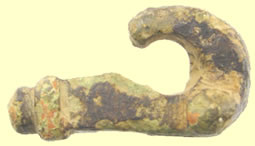 |
|||||||||
Another nice Roman piece from the same site as above - looks like a handle mount |
|||||||||
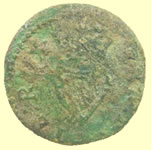 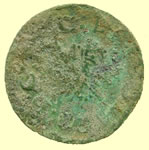 |
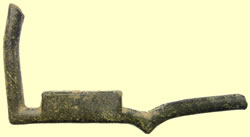 |
||||||||
1614-25 James 1st hammered copper farthing Type 3c Mintmark key General type Obv. IACO D G MAG BR (IT) Rev. FRA ET HIB REX |
Medieval chaffing dish handle |
||||||||
 |
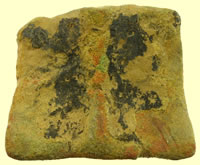 |
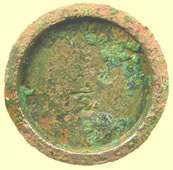 |
|||||||
Huge medieval bronze pot leg |
Medieval pot foot |
Victorian 1/2 oz trade weight |
|||||||
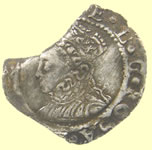 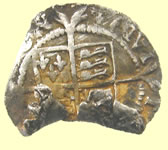 |
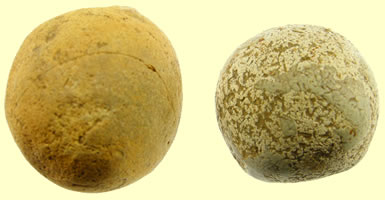 |
||||||||
1578-8 Elizabeth 1st hammered silver penny |
|
||||||||
  |
|
||||||||
17thC mount with 2 integral lugs |
Roman decorated helmet trim |
||||||||
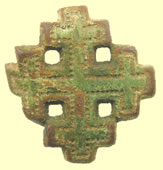 |
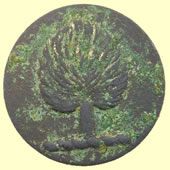 |
||||||||
| 'A badge for a Knight of the Order of the Holy Sepulchre in bronze and dating somewhere around C13/14th possibly very slightly later . This is a very scarce item and it relates to The Equestrian Order of the Holy Sepulchre of Jerusalem being a Catholic chivalric order of Knighthood that traces its roots to Godfrey of Bouillon, principal leader of the First Crusade. According to reliable sources in the Vatican and Jerusalem, it began in historical reality as a mixed clerical and lay confraternity (association) of pilgrims which gradually grew around the most central of the Christian holy places in the Middle East, the Holy Sepulchre or the tomb of Jesus Christ.This would have been a pin for a member of the order , there is a mark on the reverse where the original pin would have been fixed ' | 19thC livery button |
||||||||
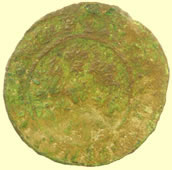  |
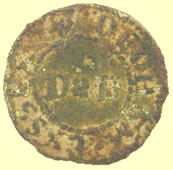 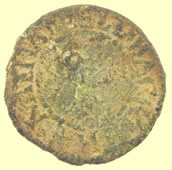 |
||||||||
1586 Hans Krauwincel II Rose orb Jeton HANNS KRAVWINCKEL IN NVRENB |
1666 Nathaniel Backler of Dedham Copper trade farthing |
||||||||
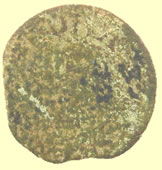  |
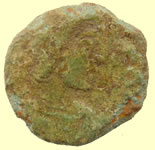  |
||||||||
1664 Joseph Gleson of Dedham Copper trade farthing |
4thC Roman bronze sent for ID 0.85g, 11.30mm |
||||||||
 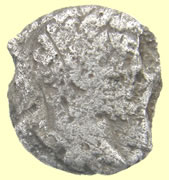 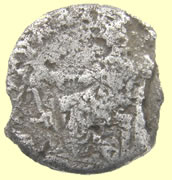  |
|||||||||
Partially cooked 3rd C Roman silver Your silver piece seems likely to be a Severan-era denarius, the curly hair could be any one of a number of youthful Severan rulers. (c. 200-235 AD, approximately - Young Caracalla, Geta, Elagabalus, Severus Alexander [not too likely] are some of the usual suspect of this dynasty) The shape of the face and head don't remind me of M. Aurelius as Caesar, who was also portrayed with tightly-curled hair. The reverse could be any one of a number of seated figures, but more likely Pax or Jupiter than others I can think of offhand - we'll need to see if it's a female or male seated figure and what attributes (objects) are associated with the figure.
We should be able to tell better after a bit of a simmer.
Mark
|
|||||||||
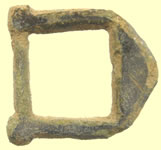 |
 |
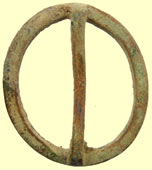 |
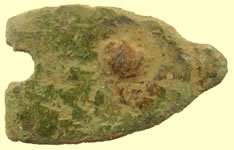 |
||||||
1550 -1650 spur buckle |
17thC mount with 2 integral lugs | 17th baldric buckle |
Medieval strap end - 2 rivet fixings |
||||||
 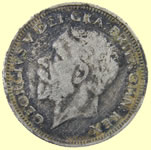 |
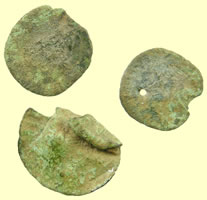 |
||||||||
1928 George V milled silver sixpence (154) |
1 - 1614 James 1st hammered copper farthing and 2 - 1634 Charles 1st hammered copper rose farthings |
||||||||
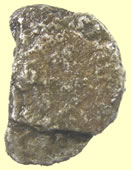 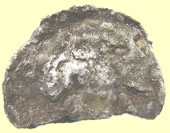 |
  |
||||||||
Roman silver coin still in the 'cooker' to remove crust |
16thC Tudor button |
||||||||
 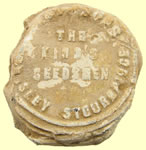 |
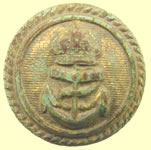 |
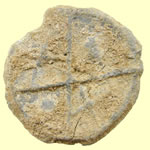 |
|||||||
20thC lead bale seal |
RN Capt / Commander - 1901 Other Ship's Officers - 1901 In use 1901 - 1952 |
15thC lead token - unusual stars in quadrents |
|||||||
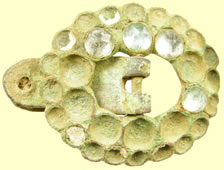 |
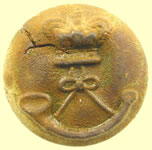 |
 |
|||||||
17thC spur decoration - glass stone setting |
19thC Rifle brigade button |
18thC Norway copper coin |
|||||||
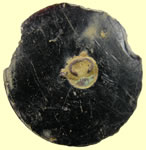  |
  |
||||||||
Georgian glass button |
17thC oval mount with single integral lug |
||||||||
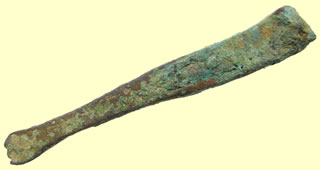 |
  |
||||||||
Medieval ear wax scraper - bowled end |
1490-1504 Henry VII hammered silver sovereign penny, No initial mark Archbishop Rotherham issue - key beneath shield Obv King entroned holding septre and orb,two double pillars Rev York mint |
||||||||
 |
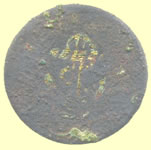 |
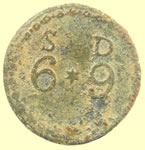  |
|||||||
Shipping line button - not checked ref books yet |
Capt / Commander - 1774-1787 RN Master & Mate - 1787-1807 |
1770's pattern coin weight - 6 shillings and 9 pence |
|||||||
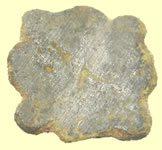 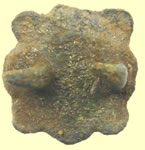 |
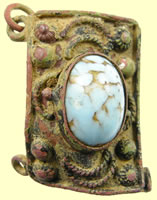 |
||||||||
17thC mount with 2 integral lugs |
Interesting wire decorated neck chain clasp with stone - could be as early as late 16thC Tudor |
||||||||
  |
 |
||||||||
1819 George III milled silver sixpence (155) |
17thc hooked fastener |
||||||||
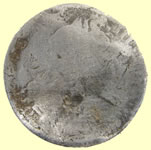  |
 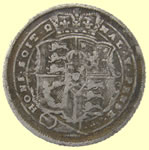 |
||||||||
1696 William III milled silver sixpence (156) |
1819 George III milled silver sixpence (157) |
||||||||
6th to 3rd Century BC Iron age brooch, some gilding remains 12.20g, 37.99mm H x 6.35mm W |
|||||||||
  |
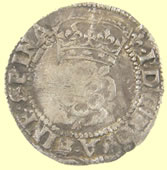  |
||||||||
1573-8 Elizabeth 1st hammered silver penny |
1623-4 James 1st hammered silver half groat – Lis mintmark 3rd coinage |
||||||||
 |
 |
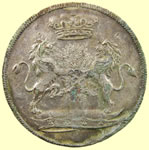 |
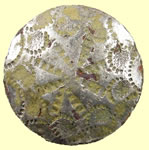 |
||||||
19thC corporation button |
19th C livery button |
19th C livery button |
Georgian dress button |
||||||
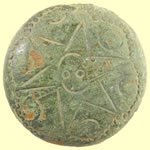 |
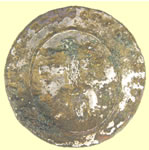 |
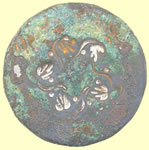 |
|||||||
17th C button |
19th C livery button |
Georgian dress button |
|||||||
|
  |
||||||||
Roman tulip shaped pin head |
1722 George 1st 'dump issue' copper farthing in great shape |
||||||||
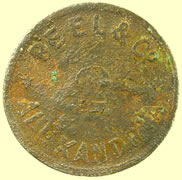  |
|
||||||||
19thC trade token, Peel & Co Alexandria - 2 shillings Rev - Lion facing left holding a knife |
1832 half penny token, province of upper Canada |
||||||||
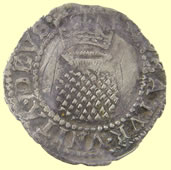 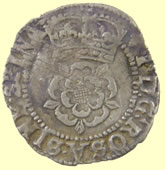 |
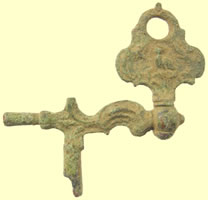 |
||||||||
1623-4 James 1st hammered silver half groat - 3rd coinage Lis mintmark |
Georgian watch winder |
||||||||
  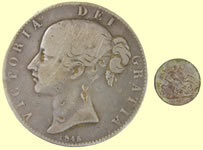 |
|||||||||
Tiny Late bust Victorian copper coin in the style of a guinea, probably a token or model coinage - Comparison size to a Victorian crown |
|||||||||
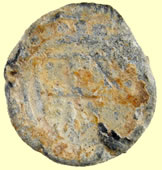 |
 |
 |
|||||||
13th C Medieval lead coin weight - 4 pellets in each quadrant of a shield |
|||||||||
Prince of Wales feathers button - Army? |
Neat Essex button with RWM ? |
||||||||
ARMS: Gules three Seaxes fessewise in pale Argent pomels and hilts Or points to the sinister and cutting edges upwards. Granted 15th July 1932. ARMS: Gules a Portcullis chained Or studded and spiked Azure. Motto 'OMNIA BONA BONIS' - To the good all things are good.
|
1371 Feudal French Jetton – Loraine and Bar type |
||||||||
 |
  |
||||||||
Norwich Union Society button Norwich Union was founded in 1797 in Norwich when Thomas Bignold, a 36 year old merchant and banker formed the “Norwich Union Society for the Insurance of Houses, Stock and Merchandise from Fire”. To begin with Norwich Union was formed as a mutual insurer. During 1808 Thomas Bignold formed a 2nd mutual called Norwich Union Life Insurance Society. In 1823 “Norwich Union Society for the Insurance of Houses, Stock and Merchandise from Fire” demutualised and was absorbed into the Norwich General Assurance Company. It was normal at the time for insurance companies that insured against fire to have their own fire brigade which were designed to protect only the society’s policyholders property. The last private brigade was given up in 1929 in Worcester. |
London (Tower Hill). A 1790 Halfpenny Masonic Token. The central arms surrounded by the legend, "Prince Of Wales Elected Gm. 24 Nov 1790*: reverse, central cherubic triangle, "Wisdom Strength & Beauty" in Italian characters, surrounded by the legend, "Sit Lux Et Lux Fuit". The coin edge cast, "Payable London Or Dublin oxoxoll. Ref: No 26 D&h 369-372 See p.123, ills. 206/207: R.C. Bell: Commercial Coins 1787-1804, Newcastle upon Tyne, 1963 |
||||||||
  |
|||||||||
1625 Charles 1st penny |
|||||||||
More find pages Milled silver count + 1 as there are 2 - 123's total is 154
|
|||||||||
 |
|||||||||
